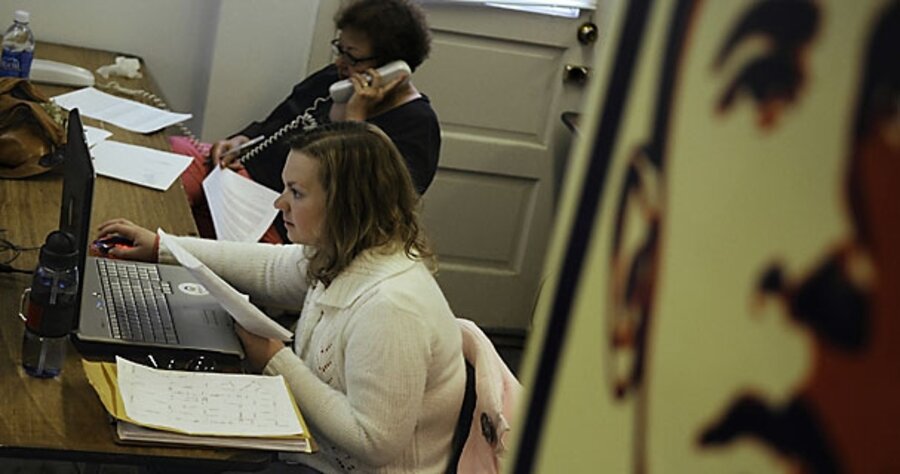Under Obama, a newly interactive government?
Loading...
| New York
Want to give Barack Obama a piece of your mind about what’s wrong with the United States government? Just go to www.change.gov and click on “Share Your Ideas.”
A man named John from Seattle did: “I am so tired of special interests getting the best of us all.”
So did Lexington from San Diego: “I’d like to see an agenda that focuses on promoting transparency....”
The website is the official, online face of the Office of the President Elect. It gives a first glimpse of how Mr. Obama intends to harness technology to create a cutting-edge, participatory democracy in a similar way he used Internet connectivity to transform campaigning.
The idea is premised on the digital world’s potential to transform the US into one large cyber town-hall meeting: Every citizen will ideally have a window into the workings of government and an opportunity to tell elected leaders exactly what they think of it.
It’s an idealistic notion that will require some concrete changes – from a large investment in upgrading government computers to a change in the rules and regulations that guide government employees. Most important, it will require a radical transformation of the entrenched culture of secrecy and the dominance of special interests that define how Washington operates.
“This will be the first president who has an opportunity to use interactive technology in ways we’ve never seen – it really is remarkable,” says Gary Bass, executive director of OMB Watch, a nonprofit organization that promotes greater government accountability and transparency in Washington. “What was so unique about the Obama campaign [was] that interactivity was real. When people commented on something, they saw things happen. That’s what the people are expecting the president to do now.”
Obama will not be the first online president. That was Bill Clinton, who set up the White House’s first website in 1994 and in 1996 ordered all federal agencies to get online as well. The websites were pretty rudimentary sources of information. President Bush took that a step further, turning the White House website into a “repository of all the things the president was doing on that day,” according to David Almacy, who was the White House’s Internet director from 2005 to 2007.
But as Mr. Almacy discovered, much of what the White House could do was constrained by a lack of resources. He had a staff of six to run the White House’s Internet operations. The Obama campaign had 95 people. Then there are the federal rules and regulations.
For instance, when Mr. Bush went to New Orleans in the aftermath of hurricane Katrina, he urged Americans to log on to RedCross.org. Almacy decided to put up a link on the White House website. Within hours, the White House counsel’s office was directing him to take the link down because it might be perceived as endorsing one organization over another, says Almacy.
There are privacy questions, too. Many websites use “cookies,” electronic calling cards that websites leave on your computer to identify you if you return. Federal privacy policy discourages their use, saying there should be a “presumption” that they’re not used on federal websites.
But there is a loophole. Cookies can be used if an agency can demonstrate a compelling need and gets special permission. The Obama transition team is taking advantage of that. Change.gov uses cookies and states that in its privacy policy.
“Obama will probably run into some more rules that are going to need amending,” says Robert Bluey, director of the Center for Media and Public Policy at the Heritage Foundation. “But I think it’s absolutely great that people will have more opportunity to have a say in government and it’s pretty evident from change.gov that’s the direction that Obama’s going to take.”
Obama has set out a clear road map as to how he hopes to accomplish that. It starts with the appointment of a chief technology officer with cabinet-level powers who will oversee technological operations across the government.
“Most people from the 20th century think of technology as a separate issue from others like healthcare or energy, but it’s not just one of many issues [like one of many slices of a pie], it’s the pan that supports innovation and change for all of the other issues,” says Andrew Rasiej, copresident of techpresident.com. “It’s essential that the Obama administration put someone in a position who understands that.”
Federal employees will also have to change how they operate, setting up pilots in citizen participation, which means “Wikis [websites where visitors can change the content], comment sections, collaborative projects, public review of pending policies, and online dialogues,” says Mr. Bass.
That may not sit well with some longtime federal employees. “It’s a radical change,” says Ari Schwartz, vice president of the Center for Democracy and Technology. “But it’s in line with the way our government is supposed to work.”
Then there’s the larger question of whether a citizenry that’s disillusioned with government is ready to get more involved. The optimists here abound.
“What’s been proven through this election process is that there’s a newly engaged and empowered citizenry that is ready, able, and willing to partner with the Obama administration on rebooting American democracy in a 21st-century model of participation,” says Mr.Rasiej.





